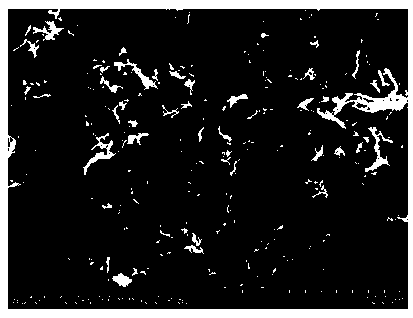Method for preparing carbon aerogel by using waste seaweed residues as raw material
A carbon aerogel, seaweed residue technology, applied in aerogel preparation, carbon preparation/purification, chemical instruments and methods, etc., can solve problems such as waste of natural resources, marine fishery economy and ecological damage, and achieve the preparation cycle Short, solve the limited application scope, the effect of environmental protection and safety in the production process
- Summary
- Abstract
- Description
- Claims
- Application Information
AI Technical Summary
Problems solved by technology
Method used
Image
Examples
Embodiment 1
[0014] Follow the steps below in turn:
[0015] a. Wash the waste seaweed residue with deionized water to remove the sediment, soak it in excess ethanol for 24 hours, remove the upper layer of scum, filter it, dry it in a vacuum constant temperature drying oven at 100°C for 20 hours, and then crush it , sieve to obtain seaweed residue particles, add excess sodium hypochlorite, stir at 60°C for 5 hours, cool to room temperature, filter and remove the supernatant, add 0.5mol / L sodium hydroxide solution to the precipitate, stir well and centrifuge to take the precipitate , then add 1mol / L dilute hydrochloric acid and boil for 5 minutes, wash repeatedly with deionized water until neutral, centrifuge and place in a drying oven to dry to obtain seaweed cellulose;
[0016] b. Put seaweed cellulose in urea / sodium hydroxide mixed aqueous solution, the mass concentration of seaweed cellulose is 5%, ultrasonically disperse at room temperature for 45 minutes, the mass ratio of urea to sod...
Embodiment 2
[0021] Follow the steps below in turn:
[0022] a. Wash the waste seaweed slag with deionized water to remove the sediment, soak it in excess ethanol for 24 hours, remove the upper layer of scum, filter it, dry it in a vacuum constant temperature drying oven at 100°C for 12 hours, and then crush it , sieve to obtain seaweed residue particles, add excess sodium hypochlorite, stir at 60°C for 5 hours, cool to room temperature, filter and remove the supernatant, add 0.5mol / L sodium hydroxide solution to the precipitate, stir well and centrifuge to take the precipitate , then add 1mol / L dilute hydrochloric acid and boil for 5 minutes, wash repeatedly with deionized water until neutral, centrifuge and place in a drying oven to dry to obtain seaweed cellulose;
[0023] b. Put seaweed cellulose in urea / sodium hydroxide mixed aqueous solution, the mass concentration of seaweed cellulose is 3%, ultrasonically disperse at room temperature for 30 minutes, the mass ratio of urea to sodium...
Embodiment 3
[0028] Follow the steps below in turn:
[0029] a. Wash the waste seaweed slag with deionized water to remove the sediment, soak it in excess ethanol for 24 hours, remove the scum in the upper layer, filter it, dry it in a vacuum constant temperature drying oven at 100°C for 24 hours, and then crush it , sieve to obtain seaweed residue particles, add excess sodium hypochlorite, stir at 60°C for 5 hours, cool to room temperature, filter and remove the supernatant, add 0.5mol / L sodium hydroxide solution to the precipitate, stir well and centrifuge to take the precipitate , then add 1mol / L dilute hydrochloric acid and boil for 5 minutes, wash repeatedly with deionized water until neutral, centrifuge and place in a drying oven to dry to obtain seaweed cellulose;
[0030] b. Put seaweed cellulose in urea / sodium hydroxide mixed aqueous solution, the mass concentration of seaweed cellulose is 8%, ultrasonically disperse at room temperature for 60 minutes, the mass ratio of urea to so...
PUM
| Property | Measurement | Unit |
|---|---|---|
| density | aaaaa | aaaaa |
| density | aaaaa | aaaaa |
| density | aaaaa | aaaaa |
Abstract
Description
Claims
Application Information
 Login to View More
Login to View More - R&D
- Intellectual Property
- Life Sciences
- Materials
- Tech Scout
- Unparalleled Data Quality
- Higher Quality Content
- 60% Fewer Hallucinations
Browse by: Latest US Patents, China's latest patents, Technical Efficacy Thesaurus, Application Domain, Technology Topic, Popular Technical Reports.
© 2025 PatSnap. All rights reserved.Legal|Privacy policy|Modern Slavery Act Transparency Statement|Sitemap|About US| Contact US: help@patsnap.com


